by Stefano Serafini
Istanbul is a dynamic, multicultural, vibrant metropolis. It is also a young one. The average age of the population is 31 years old. This adds to the deeply layered heritage of the three great civilizations in which Istanbul, sitting among Asia and Europe, has been the capital for two millennia. Contrasts characterize the identity of the city: religion and secularism, capitalism and traditional social relationships, strong power and alive opposition. Even physically, the city exposes a powerful and beautiful opposition between the verticality of its steep over-built hills and the lanes running parallel to the sea faced by houses, ports, and plants.
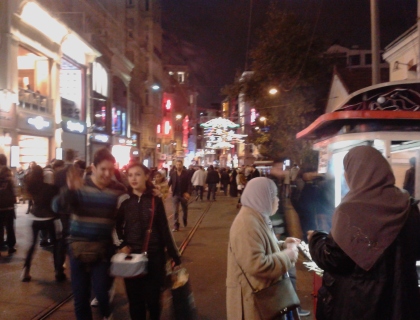
Night life in Istanbul
Istanbul has 14 million inhabitants. Yet, it is still capable of giving room to an immigration flood that would result unsustainable to any other European city, at a pace of almost 400,000 newcomers per year. Its transport system’s efficiency rivals that of London, and of course Istanbul is growing. Interestingly, most immigrants find their places by self-building, squatting, reshaping, and reviving old abandoned buildings and neighborhoods. At the same time, huge skyscrapers pop up like mushrooms towards the North, pushed by the government’s run towards the finishing line of 2023, when the Republic of Turkey will celebrate 100 years of history and possible entry into the top 10 world economies (see the forthcoming book by Yoann Morvan and Sinan Logie, Istanbul 2023. Paris: B2, expected November 2014).
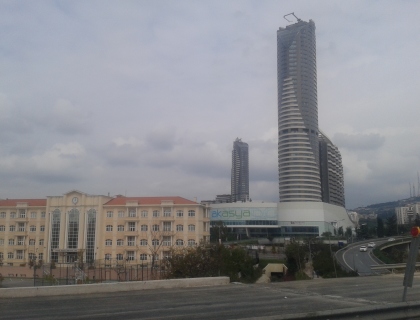
Istanbul real estate’s skyrocketing in all senses.
Different cultures are changing the city by bringing their needs and visions in from the bottom. A robust real estate capitalism acts instead from the top. The two forces co-exist, mingle, and clash.
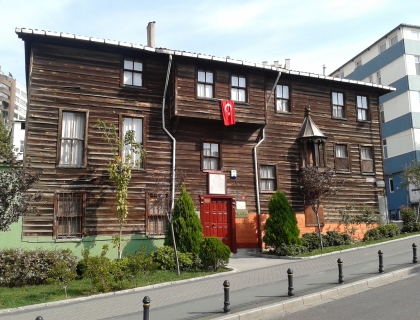
A beautiful wooden traditional house still surviving in a central area of Istanbul.
There’s enough to make Istanbul into an urban design hot spot. Issues are real, and these issues lead inspiration and creativity by way of necessity. So, what is going on in Istanbul’s Faculties of Architecture, Design, and Urban Planning?
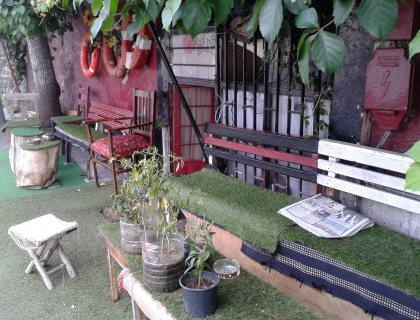
A self-designed taxi station in Istanbul. Taxi drivers wait here for calls drinking tea and chatting.
First of all, they are multiplying. Thirty-three private foundation universities have been established in Istanbul since 1992, fifteen of which during the last seven years. In 1992 and in 2010, two new public universities were added to the previously existing six. Most of them offer Faculties or Departments of Architecture, despite the fact that everybody agrees that jobs won’t increase as fast as the new professionals for at least the coming five years. The economy is growing and real estate business has a relevant role, but the education of the future middle class cannot contrast the worldwide decline of intellectual labor.
I had the pleasure of visiting the Faculties of Architecture at Bilgi University, Kadir Has University, and Özyeğin University in October.
The Faculty of Architecture and Design of Bilgi University has recently moved to an impressive place – the Silahtarağa campus that was the first power plant of the Ottoman Empire. Students and professors work in a modern building between huge iron machines, steel, and concrete, formerly part of the power plant, and next to the the Modern Art Museum and other amenities of SantralIstanbul – a paradise indeed for industrial design lovers.
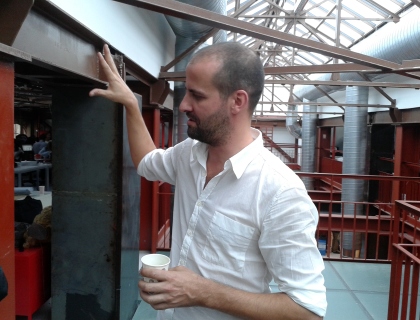
Adrien Cools and Regle d’Or de l’Urbanisme awards winner Professor Sinan Logie at the Faculty of Architecture of Belgi University.
The feeling is fresh. Students work together with their teachers, presenting models and discussing ideas. Sinan Logie, a young and brilliant professor who leads two Masters in Architecture studios, explained to me that his students are working in partnership with the inhabitants of a neighborhood who won a court case against the government. They succeeded in stopping a top-down urban transformation process. Then he introduced me to the work of Turgut Cansever (1921-2009), the “Wise Architect,” who was advocating the Islamic concept of a wooden city in order to respect the new generation’s right to reshape the urban space according to their needs.
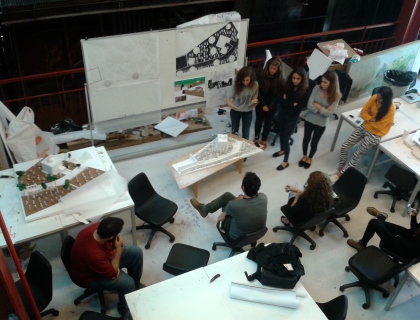
Students at work, Faculty of Architecture, Bilgi University.
Professor Dr. Zuhal Ulusoy is the Dean of the Faculty of Art and Design at Kadir Has. A full size copy of the Nolli plan of Rome hangs behind her desk. Short hair, stylishly elegant, and charming, she shows a practical attitude and a wide culture. “I’m not very much updated on what is going on about design research in Amsterdam, London, or Berlin,” she says modestly, giving the idea that there’s already enough to deal with in Turkey. She studied at Carnegie Mellon and Orta Doğu /Middle East Technical University, and her publications focus on the “border” compromise that highlight contrasts between modernity and tradition, sea and land, as well as theory and practice in design.
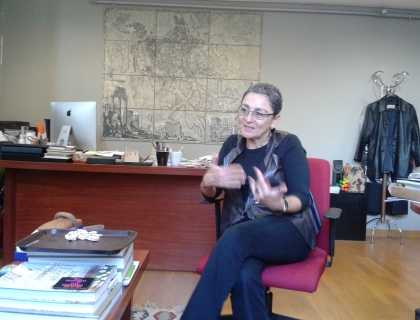
Professor Dr. Zuhal Ulusoy, Dean of the Faculty of Art and Design, Kadir Has University.
At the Faculty of Architecture and Design of Özyeğin University, I offered a lecture on Biourbanism and Biophilic design. Only one out of about fifty students knew of biophilic design; an average very similar to that of Italian students, for instance. Nevertheless, they were familiar with the concept of biomimicry. The difference is that biophilia (linked to human-oriented design) has to do with psychology, medicine, and wide social issues, whilst biomimicry focuses on the technocratic use of natural mechanisms in design. In fact, despite a practical attitude, students showed interest towards a multidisciplinary and humanistic approach to architecture. This young Faculty has expanded quickly since its foundation (established just two years ago) towards both updated technical knowledge and a social-oriented integration of different disciplines. The Dean, Professor Dr. Orhan Hacıhasanoğlu, is an engineer with a real interest for social change by way of design. He has a 3D printed model on his desk, has set up a very modern lab for graphic design, and at the same time, speaks with passion about an interdisciplinary PhD program devoted to join Social Sciences and Design, with an approach that seems very similar to biourbanism.
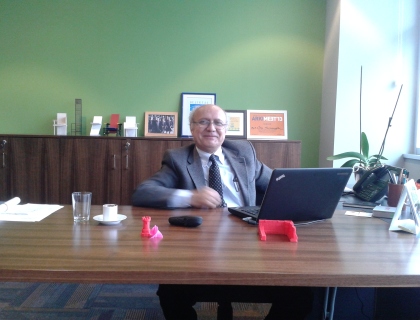
Professor Dr. Orhan Hacıhasanoğlu, Dean of the Faculty of Architecture and Design, Özyeğin University.
The dynamism and energy of the community is pretty impressive. Students and teachers share the space of a brand new campus outside the city, complete with all facilities, from dorms to a library and restaurant. The Head of the Department of Architecture, Professor Dr. Murat Şahin, was just back from a series of conferences in the USA and Europe when we met. Despite the jet lag, he generously spent time showing his students’ works, including a recent report after a study travel to Rome.
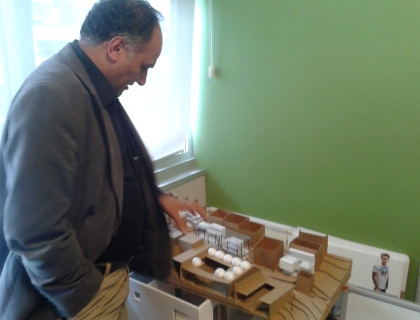
The Head of the Department of Architecture, Özyeğin University, Professor Dr. Murat Şahin, showing a model in his office.
We talked about the possibility of cooperating on a common research project on Mediterranean urbanism and biophilia that brings together urban code analysis, psychology, new economic and socio-urban autochthonous models, and an earnest proactive attitude towards contemporary urban and professional issues. The premises are heartening. Italian and Greek Universities have of course already been collaborating with their Turkish colleagues for quite some time. We share a common culture, a critical vision about the actual system, human warmth, and ambitions for changing the world. However, the epistemological frame of biourbanism can add a new and relevant link to such a cooperation. I trust we’ll make it.